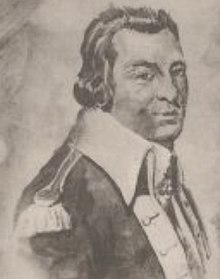John Morin Scott
John Morin Scott | |
|---|---|
 From a 1777 drawing by John Trumbull | |
| 1st Secretary of State of New York | |
| In office March 13, 1778 – September 14, 1784 | |
| Preceded by | Inaugural holder |
| Succeeded by | Lewis Allaire Scott |
| Personal details | |
| Born | 1730 Brigadier General |
| Commands | 1st and 2nd New York Battalions; New York militia regiments |
| Battles/wars | Battle of Brooklyn (Long Island) Battle of Harlem Heights Battle of White Plains |
John Morin Scott (1730 – September 14, 1784) was a lawyer, military officer, and statesman before, during and after the American Revolution.
Early life

Scott was born in
His father was the eldest of nine children born to Captain John Scott (1678–1740), who emigrated to New York City, where he received the rights of citizenship in 1702.
He attended
Career
After graduation from Yale and further study, he was admitted to the New York bar association in 1752 and practiced law in Manhattan, where he also served as an alderman from 1756 to 1761. In 1752, along with William Livingston and William Smith, he founded a weekly journal, the Independent Reflector.[5] From 1756 to 1761, he served as a New York alderman.[1] In 1768, he was elected to membership in the American Philosophical Society.[6]
American Revolution
Scott was a founding member of the
Twenty days later, on September 16, 1776, Scott led the same battalions and regiments at the Battle of Harlem Heights, an American victory. On October 28, 1776, his forces participated in the Battle of White Plains.[4]
Post War life
In 1776, Scott was a member of the
Instead, he became New York's first
Personal life

Scott was married to Helena Rutgers (1730–1798),[3] a daughter of Petrus Rutgers and Helena (née Hooglant) Rutgers.[8] Together, they were the parents of:[4]
- Mary Morin Scott (1753–1796), who married John Litchfield in 1770. After his death in 1775, she married Charles McKnight (1750–1791) in 1778.[4]
- Lewis Allaire Scott (1759–1798), who married Juliana Sitgreaves (1765–1842). Lewis was one of the two Deputy Secretaries of State during his father's tenure, and in 1784 was appointed to succeed him, dying in office in 1798.[4]
Scott died in New York City on September 14, 1784, and his body was
References
- ^ a b c d e "SCOTT, John Morin - Biographical Information". bioguide.congress.gov. Biographical Directory of the United States Congress. Retrieved August 15, 2019.
- ^ a b Simpson, Henry (1859). The Lives of Eminent Philadelphians, Now Deceased. Philadelphia: W. Brotherhead. p. 867ff. Retrieved August 15, 2019.
- ^ a b The Scott Genealogical Quarter, Vol. 3, No. 4. Heritage Books. January 1990. p. 127. Retrieved August 15, 2019.
- ^ a b c d e f g Jordan, John Woolf (1911). Colonial Families of Philadelphia. Lewis Publishing Company. p. 1434. Retrieved August 15, 2019.
- ISBN 0-404-51548-7
- ^ Bell, Whitfield J., and Charles Greifenstein, Jr. Patriot-Improvers: Biographical Sketches of Members of the American Philosophical Society. 3 vols. Philadelphia: American Philosophical Society, 1997, 3:481–487.
- New International Encyclopedia(1st ed.). New York: Dodd, Mead.
- ^ Charter, Constitution, By-laws, Officers, Committees, Members, Etc., 1896. Colonial Society of Pennsylvania. 1908. p. 126. Retrieved August 15, 2019.
External links
- United States Congress. "John Morin Scott (id: S000179)". Biographical Directory of the United States Congress.
- Political Graveyard
